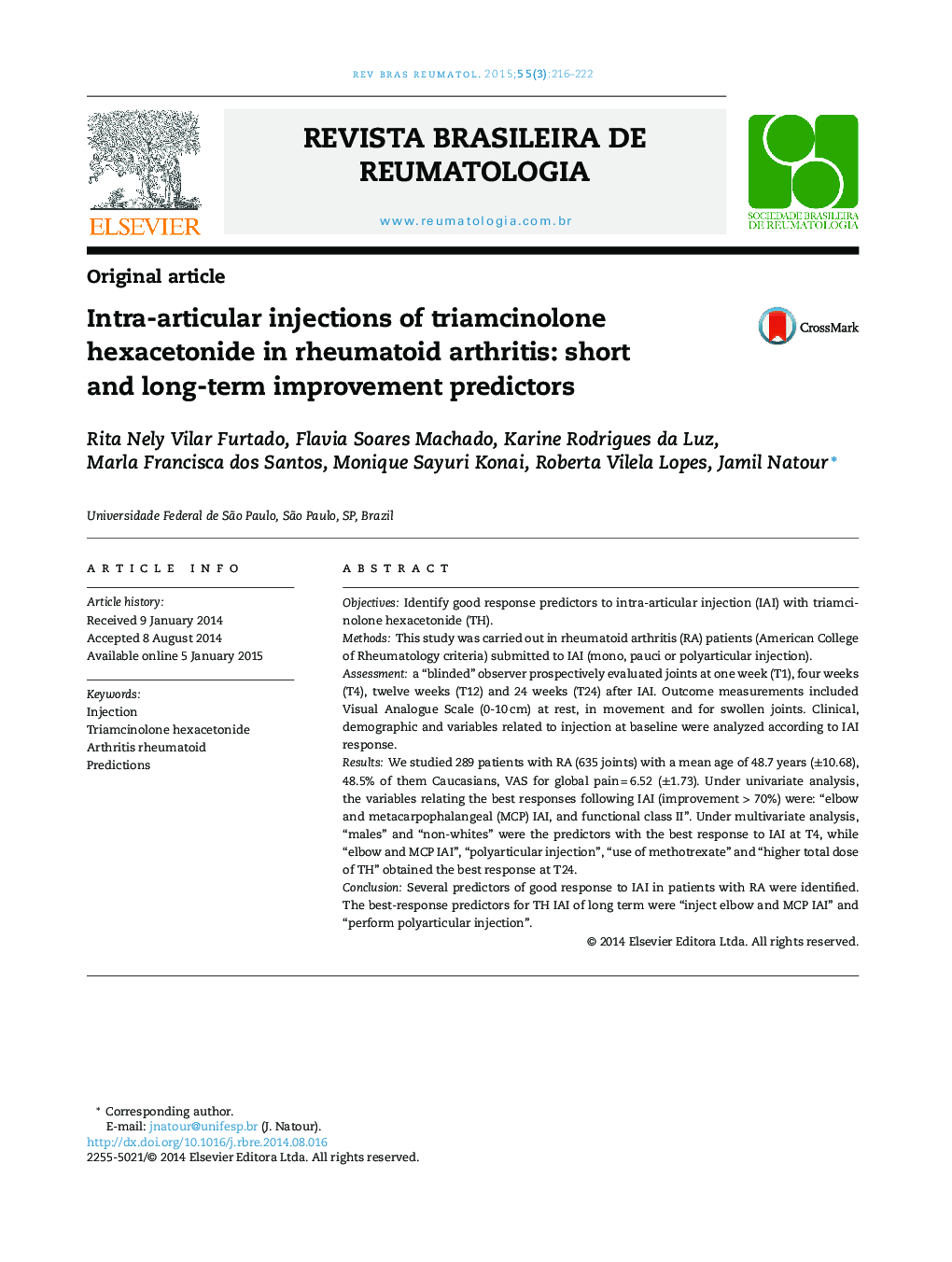| کد مقاله | کد نشریه | سال انتشار | مقاله انگلیسی | نسخه تمام متن |
|---|---|---|---|---|
| 3385059 | 1220570 | 2015 | 7 صفحه PDF | دانلود رایگان |
ObjectivesIdentify good response predictors to intra-articular injection (IAI) with triamcinolone hexacetonide (TH).MethodsThis study was carried out in rheumatoid arthritis (RA) patients (American College of Rheumatology criteria) submitted to IAI (mono, pauci or polyarticular injection).Assessmenta “blinded” observer prospectively evaluated joints at one week (T1), four weeks (T4), twelve weeks (T12) and 24 weeks (T24) after IAI. Outcome measurements included Visual Analogue Scale (0-10 cm) at rest, in movement and for swollen joints. Clinical, demographic and variables related to injection at baseline were analyzed according to IAI response.ResultsWe studied 289 patients with RA (635 joints) with a mean age of 48.7 years (±10.68), 48.5% of them Caucasians, VAS for global pain = 6.52 (±1.73). Under univariate analysis, the variables relating the best responses following IAI (improvement > 70%) were: “elbow and metacarpophalangeal (MCP) IAI, and functional class II”. Under multivariate analysis, “males” and “non-whites” were the predictors with the best response to IAI at T4, while “elbow and MCP IAI”, “polyarticular injection”, “use of methotrexate” and “higher total dose of TH” obtained the best response at T24.ConclusionSeveral predictors of good response to IAI in patients with RA were identified. The best-response predictors for TH IAI of long term were “inject elbow and MCP IAI” and “perform polyarticular injection”.
ResumoObjetivosIdentificar fatores preditores de resposta à infiltração intra-articular (IIA) com hexacetonide de triancinolona (HT).MétodosEste estudo foi realizado em pacientes com artrite reumatoide (AR) (segundo critérios do American College of Rheumatology) submetidos à IIA (infiltração mono, pauci ou poliarticular).AvaliaçãoUm observador “cego” avaliou prospectivamente as articulações uma semana (T1), quatro semanas (T4), 12 semanas (T12) e 24 semanas (T24) após IIA. As medidas de desfecho foram Escala Visual Analógica (0-10 cm) em repouso, em movimento e para articulações edemaciadas. As variáveis clínicas e demográficas e aquelas relacionadas à infiltração no início do estudo foram analisadas de acordo com a resposta à IIA.ResultadosForam estudados 289 pacientes com AR (635 articulações) com média de idade de 48,7 (± 10,68) anos; 48,5% eram caucasianos, EVA para dor global = 6,52 (± 1,73). Na análise univariada, as variáveis relativas às melhores respostas seguida à IIA (melhora >70%) foram: “IIA no cotovelo e metacarpofalangeanas (MCF)” e “classe funcional II”. Na análise multivariada, “homens” e “não brancos” foram os preditores com melhor resposta à IIA em T4, enquanto “IIA no cotovelo e MCF”, “infiltração poliarticular”, “uso de metotrexato” e “dose total maior de HT” obtiveram a melhor resposta em T24.ConclusãoForam identificados diversos fatores preditores de boa resposta à IIA em pacientes com AR. Os preditores de melhor resposta para IIA de HT em longo prazo foram “realizar IIA no cotovelo e MCF” e “realizar infiltração poliarticular”.
Journal: Revista Brasileira de Reumatologia (English Edition) - Volume 55, Issue 3, May–June 2015, Pages 216–222
